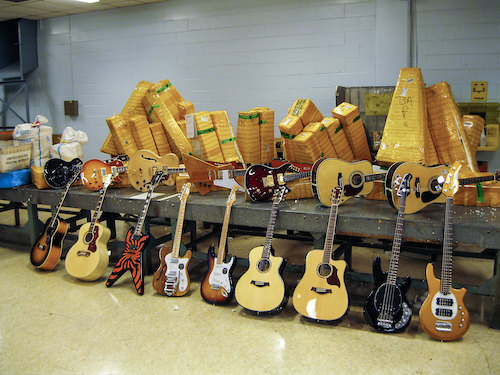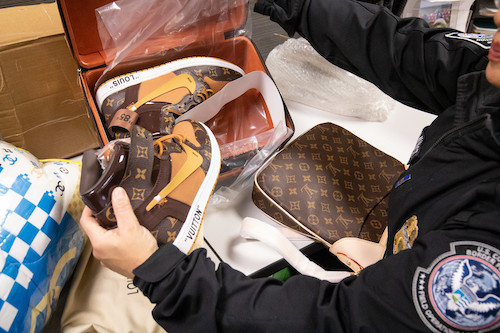“Owners of trademarks and copyrights registered in the U.S. have available a potent enforcement tool to stave off entry of increasing volume of infringing and counterfeit goods into the U.S. – recordation of these rights with U.S. Customs and Border Protection.”

U.S. Customs and Border Protection (CBP) officers working at the International and Bulk Mail Center in Jersey City, N.J. discovered over 185 counterfeit guitars with an estimated retail value of over $1,000,000 in 2014. Photo provided by: U.S. Customs and Border Protection
In 2019, U.S. Customs and Border Protection (CBP) handled more than 27,500 seizures of goods, with an estimated value of $1.5 billion, including pharmaceuticals, personal care products, automotive supplies, aerospace products, consumer electronics and sporting goods, apparel, footwear, watches and accessories. There are 328 ports of entry to the U.S. (land, air and sea). The U.S. marketplace is geographically vast, and there is no single mechanism effective as a complete solution for monitoring infringements and counterfeits.
Owners of trademarks and copyrights registered in the U.S. have available a potent enforcement tool to stave off entry of increasing volume of infringing and counterfeit goods into the U.S. – recordation of these rights with U.S. Customs and Border Protection. CBP has recently extended recordation eligibility to pending copyright applications on a temporary six-month basis. The investment for recordation is nominal, the process is simple, and the IP rights enforcement services received in return are significant.
The cost for recordation of a U.S. trademark with CBP is $190 per class of goods (10-year term) and successive renewal terms are $80 per trademark, per class. The costs for recordation (and renewal) of a U.S copyright registration are the same (with a longer term of 20 years). On an annual basis, these fees are modest, in exchange for which your business will receive enforcement assistance from well-trained CBP officers actively looking for infringement of your trademarks and copyrights across the U.S. and its territories (including Puerto Rico, the U.S. Virgin Islands, Guam and the Northern Mariana Islands).
To complete a recordation application, CBP requires a copy of the registration certificate, an image of the trademark (or copyrighted work), name(s) of authorized licensees, and the countries of manufacture for the genuine products/work. Once the IP right is recorded, CBP personnel access a database (see public version at https://iprs.cbp.gov/#/) to check suspected infringing goods information against rights-holder records at CBP. When a CBP officer examines a shipment and deems it to contain suspected infringements/counterfeits, the shipment is detained. The brand owner/rights holder is quickly contacted to verify product authenticity. The importer is also notified and has seven business days to challenge the detention. If the goods are believed to be counterfeit, CBP has latitude to seize merchandise at any time after importation, so long as probable cause can be shown.

Customs and Border Protection officers assigned to the Area Port of Jacksonville, Florida seized these items being shipped into the U.S. on Feb. 20, 2019. The Louis Vuitton/Nike shoes and case above are counterfeit and shipped directly from China. Photo by Ozzy Trevino, U.S. Customs and Border Protection.
With recordation completed, brand owners also have the option to arm CBP with additional information to aid the examination of arriving shipments to the U.S. A brand owner may upload (for access by CBP only) product identification guides and images of genuine goods. Pursuant to the Trade Secrets Act, 18 U.S.C. § 1905, CBP personnel are barred from disclosure of this proprietary information. Furthermore, a business owner/rights holder has the opportunity to provide CBP personnel with product identification training (online or in person).
The CBP recordation program does not currently extend to protect U.S. design patents. To date, the only recourse for design rights holders to exclude infringing and counterfeit imports from entry into the U.S. is to initiate an International Trade Commission investigation under Section 337 of the Tariff Act of 1930, seeking an exclusion order. In an effort to address this gap, the Counterfeit Goods Seizure Act of 2019 (CGSA) was introduced at the end of 2019, and is currently pending. Passage of this bill would give businesses a speedier and significantly more cost-effective route to enforcement of their design rights.

![[IPWatchdog Logo]](https://ipwatchdog.com/wp-content/themes/IPWatchdog%20-%202023/assets/images/temp/logo-small@2x.png)

![[Advertisement]](https://ipwatchdog.com/wp-content/uploads/2024/04/Patent-Litigation-Masters-2024-sidebar-early-bird-ends-Apr-21-last-chance-700x500-1.jpg)

![[Advertisement]](https://ipwatchdog.com/wp-content/uploads/2021/12/WEBINAR-336-x-280-px.png)
![[Advertisement]](https://ipwatchdog.com/wp-content/uploads/2021/12/2021-Patent-Practice-on-Demand-recorded-Feb-2021-336-x-280.jpg)
![[Advertisement]](https://ipwatchdog.com/wp-content/uploads/2021/12/Ad-4-The-Invent-Patent-System™.png)







Join the Discussion
One comment so far.
Charles E Miller
January 6, 2021 07:57 amDear Maria — An excellent and timely article on a highly topical theme. Congratulations on your fine contribution to the field of IP enforcement.
Charles E. Miller
LEICHTMAN LAW PLLC